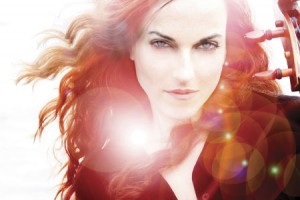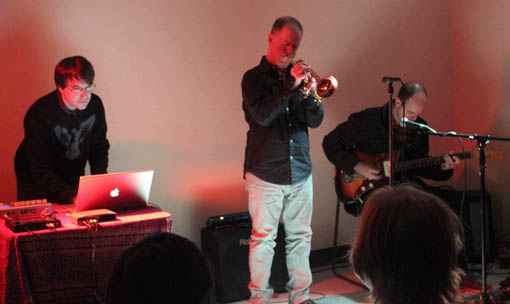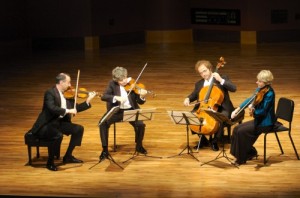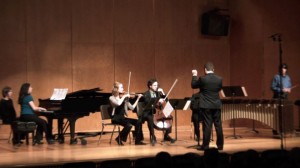Congratulations to Louis Andriessen for winning the University of Louisville’s 2011 Grawemeyer Award for Music Composition. He received the award for La Commedia, his fourth opera. This year’s award is $100,000.
The Original New Music Community
Congratulations to Louis Andriessen for winning the University of Louisville’s 2011 Grawemeyer Award for Music Composition. He received the award for La Commedia, his fourth opera. This year’s award is $100,000.
 This Friday, December 3rd, is the second concert of the season by the American Composers Orchestra at Zankel Hall. This concert “explores composers’ reactions to specific moments, pinpointed and analyzed, which have inspired them to create something entirely new.”
This Friday, December 3rd, is the second concert of the season by the American Composers Orchestra at Zankel Hall. This concert “explores composers’ reactions to specific moments, pinpointed and analyzed, which have inspired them to create something entirely new.”
The program is titled A Time & Place and includes four world premieres commissioned by ACO. There is a new piece by Douglas J. Cuomo entitled Black Diamond Express Train to Hell that features cellist Maya Beiser as soloist. The Fire at 4 a.m. is Jerome Kitzke’s homage to both the creative and ceremonial fires he has tended. Christopher Trapani explores the concept of “the West” through country guitar timbres, West African music, and psychedelic California rock in his piece, Westering. And Ryan Francis rounds out the new ACO commissions with High Line, winner of the ACO/LVMH “A Greener New York City” commission, which was inspired by New York City’s newest park.
Speaking of the High Line, you can submit your favorite photo of the High Line Park to win two free tickets to the concert. There is more information about the contest here and here but the deadline it 11Pm Monday, November 29th (sorry for the late notice!).
The orchestra will also perform another piece inspired by New York’s iconic landscape: Charles Ives’ Central Park in the Dark, which depicts what one might hear on a summer night in the park.
 We’re saddened to hear the news of Ann Southam’s death this past Thursday after a long battle with cancer. Southam was one of Canada’s foremost composers, an influential teacher at the Royal Conservatory, and longtime arts advocate, active in several groups which fostered contemporary music.
We’re saddened to hear the news of Ann Southam’s death this past Thursday after a long battle with cancer. Southam was one of Canada’s foremost composers, an influential teacher at the Royal Conservatory, and longtime arts advocate, active in several groups which fostered contemporary music.
She received numerous honors during her distinguished career. Earlier this year, she was named a member of the Order of Canada.
Southam’s oeuvre encompassed several compositional styles and genres: twelve-tone music, lyrical Neoromanticism, electroacoustic music, and postminimalism. I particularly admire her writing for the piano and have included two videos of contrasting works for piano soloist below.
…surf over to our sister ship, Chamber Musician Today, and check out today’s menu. We have the latest installment in violinist Marjorie Kransberg-Talvi’s remarkable continuing memoirs of growing up as an almost child prodigy driven by the dreams of a needy and demanding mother. Her story is as riveting as it is painful. Alison Lowell, aka oboetoast, has a piece about what you can learn from negative critiques (as in when a teacher you respect says “Oh, no, I don’t think you’re conservatory material.”) On a lighter note, Elaine Fine tells you where you can find the free sheet music for Oh Vere Iss Mine Leedle Tog Gone and Other Funny Sings for Ukelele and Andy Hollanbeck (with a little help from me in the comments) ponders Christmas music that isn’t quite as crappy as the usual fare. We’re hoping you’ll add some suggestions to the comments.
If you register at CMT, you can blog there directly when you feel like it or add your existing blog, post musical events to the calendar, create a profile to promote yourself or your group, and generally make yourself taller and more attractive. I launched the site as a lark a couple of months ago and it’s already built a decent-sized, loyal following. I have no idea what to do with it next–maybe find a sponsor? I’d like to give it to the Chamber Music America folks (with some strings attached) but haven’t been able to get anyone there to talk to me. Anybody got an idea?
Thanks to Carlton Wilkinson for sharing this on Facebook! I’ve written about Keith Rowe a couple of times for Signal to Noise, but he hasn’t been in the rotation for a while. I’m glad to see this gutsy and muscular prepared guitar performance.

Shh! We’re improvising! The Lepers of Melancholy, Houston TX (photo by Jonathan Jindra)
While reading Conversing With Cage at a bus stop today, I stumbled across this funny yet in the end profound exchange (circa 1980) between John Cage and John Robert with Silvey Panet Raymond:
How do you consider new popular music – punk, New Wave?
What is the New Wave? I don’t really know what it is. If you could point it out to me, I might have some reaction.
It’s very simple, three – , four-chord stuff, aggressive, fast.
There’s a good deal of dancing on the part of the performers?
Usually jumping up and down
I’ve seen something like that. It was entertaining to see but not very engaging.
But they use very dissonant sounds; I wonder how you felt about that?
I have no objection to dissonance.
I know you have no objections, but I wanted to know whether you felt any pleasure that things were coming round to your way of thinking.
But this isn’t it, is it? Isn’t it a regular beat?
Not all the time.
I think it’s part of show business.
Aren’t you?
No.
In a marginal way?
No. I’m much more a part of music as a means of changing the mind. Perhaps if you want to say that, I wouldn’t myself.
Opening up the mind.
A means of converting the mind, turning it around, so that it moves away from itself out to the rest of the world, or as Ramakrishna said, “as a means of rapid transportation.”
So your music in itself is not that important.
The use of it is what is important.
The use rather than the result.
That’s what Wittgenstein said about anything. He said the meaning of something was in its use.
As exasperated as I get by quotes attributed to John Cage regarding jazz improvisation, so-called popular music, and well, composing in general, I have been and will continue to be educated, provoked and inspired by his writings and music. My most recent work-in-progress for five electric guitars and electric bass is in part a homage to Cage’s Imaginary Landscape No. 1 (1939) that utilizes notation borrowed from Leo Brouwer’s wonderful guitar quartet Cuban Landscape With Rain (1984) to realize various aleatoric events. How my new piece (or for that matter Brouwer’s) would sit with Cage and his desire that music realized via chance operations covert the mind of its performers and listeners is – since he’s no longer with us – open to debate.
Maybe including “…for John Cage…” in the title of my piece isn’t appropriate?
Cage also readily admitted he was “close minded…” about many things.
Does Cage present to you a similar grab bag of ideas – some valuable, some exasperating? Has your attitude and appreciation of Cage changed over time?
P.S. Have a safe and relaxing holiday!
 The Takacs Quartet gave the U.K. premiere of Daniel Kellogg’s Soft Sleep Shall Contain You, a hauntingly beautiful, touching “Meditation on Schubert’s Death and the Maiden.” The BBC has made the performance available online here.
The Takacs Quartet gave the U.K. premiere of Daniel Kellogg’s Soft Sleep Shall Contain You, a hauntingly beautiful, touching “Meditation on Schubert’s Death and the Maiden.” The BBC has made the performance available online here.
Kellogg’s quartet is a simply beautiful, evocative work that comments–at times gently, at others savagely, ultimately transcendently–on the refrain of Schubert’s famous song, “Death and the Maiden” (and, by extension–and design–the string quartet which bears its name thanks to the variation movement based on this same music). It is a little gem, its biggest–and only–flaw, perhaps, that it feels slight for a piece that is nearly 15 minutes long (although perhaps that’s not much of a flaw at all). This is music that manages to comment on the past while making a statement of its own time, that challenges without alienating and uplifts and enlightens without being patrionizing. A deeply moving work performed impeccably by one of the world’s premiere string quartets.
Hats off, ladies and gentlemen!
Who says Barber cornered the market on Adagios?
 The University of Michigan School of Music, Theater and Dance’s second Student Composers’ concert of the year took place this last Monday, November 15. A hefty buffet of close to two hours of music, I found the evening passed by quickly and satisfactorily because each work was strikingly self-confident and virtually every moment of music was significant such that it never seemed like the pieces were treading water. Beyond this, the concert was particularly remarkable because of the prevalent display of composition students’ performing abilities. Only three of the night’s eight pieces lacked a composer-performer, and two among the other five were doubly notable because the works’ composers delivered solo performances.
The University of Michigan School of Music, Theater and Dance’s second Student Composers’ concert of the year took place this last Monday, November 15. A hefty buffet of close to two hours of music, I found the evening passed by quickly and satisfactorily because each work was strikingly self-confident and virtually every moment of music was significant such that it never seemed like the pieces were treading water. Beyond this, the concert was particularly remarkable because of the prevalent display of composition students’ performing abilities. Only three of the night’s eight pieces lacked a composer-performer, and two among the other five were doubly notable because the works’ composers delivered solo performances.
Given his enormous contribution to the concert – appearing in three works on cello, and writing another, the chamber concerto Nephelopolis – I must first mention Jeremy Crosmer, a masters student in Music Composition and a doctoral student in Cello Performance. I asked Mr. Crosmer – along with the other three composers who performed Monday evening – to comment on the relationship between his performance and his composition. Interestingly, Mr. Crosmer does not often perform his own music, though he cannot deny the strong influence performing has had on his writing, namely in the area of notation:
I’ve learned to write with the intention of leaving many musical nuances up to the performers, rather than specifying every last detail. I find that this is a very important way to keep the music alive… [by] allowing the performers freedom, I think the music can adapt to the circumstances of any given day and any given audience and concert.
From working with Mr. Crosmer on my piece, Clavdia, the opening work on Monday’s concert, I believe this perspective has informed his playing and helped him become a gifted interpreter of new music. His other performances second my observation, namely David Heetderks’ Stratus, a beautiful duo for cello and piano. Stratus decorated the clear pandiatonicism and modality of its melodies with captivating textures and a friendly, yet unpredictable, form. Mr. Crosmer and his companion, pianist Justin Snyder, presented Stratus in a light and charming manner, perfectly manifesting the program note’s claim that the work “reaches for the sky”.
Mr. Crosmer’s final performance came on the last piece of the first half: Roger Zare’s string quartet Road Trip. Explained in detail in its program note, Road Trip is a musical depiction of a cross-country vacation from Mr. Zare’s youth. The work was cinematic in its portrayal of the journey, beginning with ostinati to capture the forward-moving monotony of car travel and – in the second movement – using references to jazz and mariachi music to more clearly state the distance covered in the piece’s narrative backdrop. Contained within the demands of the quartet, Mr. Crosmer’s virtuosity emerged most prominently in the final movement – Pacific Coast Highway – which featured the cello as a soloist against cloudy figures in the rest of the quartet, meant to represent fog.
The New York Philharmonic kicks off its second season of the new music series CONTACT! this Friday and Saturday at Symphony Space and the Met Museum (tickets/details here). The theme of the concert is spectralism. The program pairs Souvenir, a new work written in memory of Gérard Grisey by NYPO composer-in-residence Magnus Lindberg, with Grisey’s own Quatre chants pour franchir le seuil. Lindberg studied with Grisey, and he talks about the connections between them in the video interview below.
And more about his new piece:
And there are lots more video goodies and links over at the NY Phil’s Tumblr page.